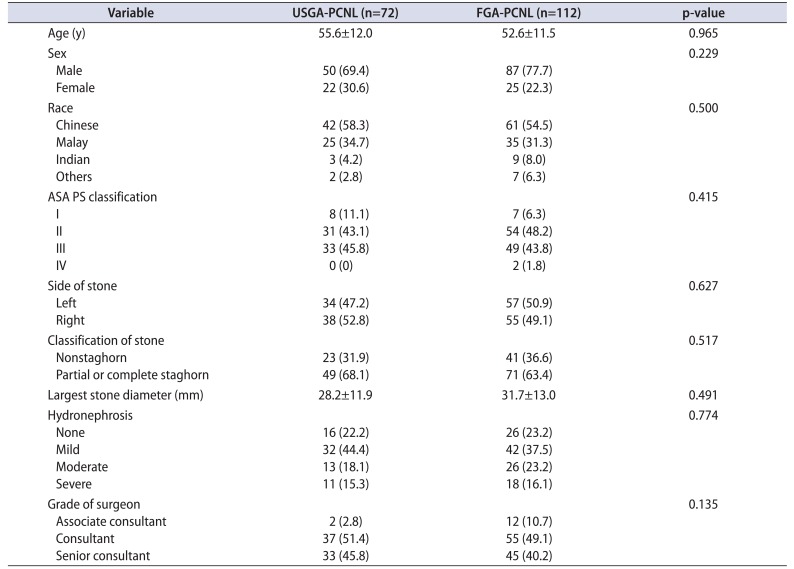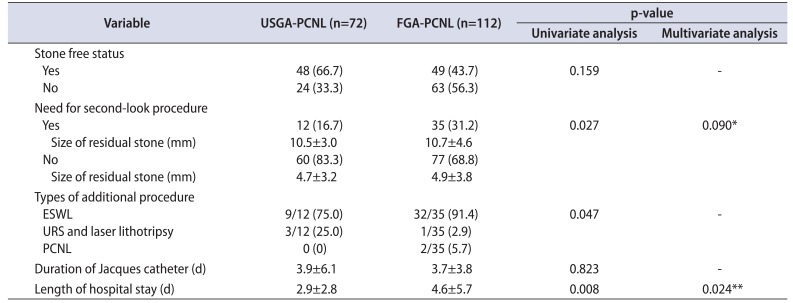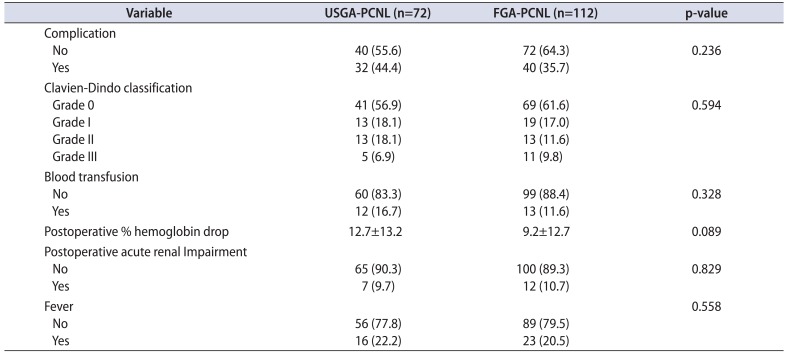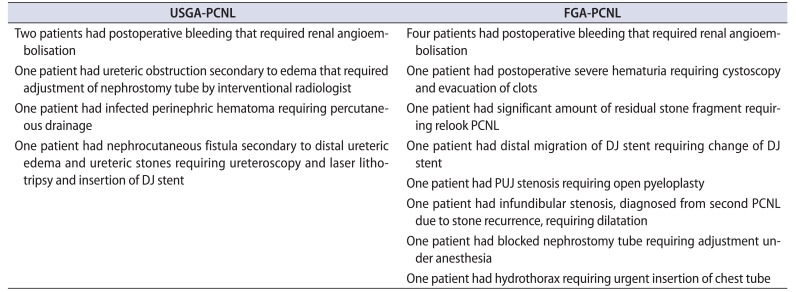1. Rao PN, Faulkner K, Sweeney JK, Asbury DL, Sambrook P, Blacklock NJ. Radiation dose to patient and staff during percutaneous nephrostolithotomy. Br J Urol. 1987; 59:508–512. PMID:
3690178.

2. Bowsher WG, Blott P, Whitfield HN. Radiation protection in percutaneous renal surgery. Br J Urol. 1992; 69:231–233. PMID:
1568094.

3. Karamcheti A, O'Donnell WF. Percutaneous nephrolithotomy: an innovative extraction technique. J Urol. 1977; 118:671–672. PMID:
916071.

4. Zhou X, Gao X, Wen J, Xiao C. Clinical value of minimally invasive percutaneous nephrolithotomy in the supine position under the guidance of real-time ultrasound: report of 92 cases. Urol Res. 2008; 36:111–114. PMID:
18251020.

5. Hosseini MM, Hassanpour A, Farzan R, Yousefi A, Afrasiabi MA. Ultrasonography-guided percutaneous nephrolithotomy. J Endourol. 2009; 23:603–607. PMID:
19335156.

6. Yan S, Xiang F, Yongsheng S. Percutaneous nephrolithotomy guided solely by ultrasonography: a 5-year study of >700 cases. BJU Int. 2013; 112:965–971. PMID:
23889729.
7. Chi Q, Wang Y, Lu J, Wang X, Hao Y, Lu Z, et al. Ultrasonography combined with fluoroscopy for percutaneous nephrolithotomy: an analysis based on seven years single center experiences. Urol J. 2014; 11:1216–1221. PMID:
24595927.
8. Basiri A, Ziaee AM, Kianian HR, Mehrabi S, Karami H, Moghaddam SM. Ultrasonographic versus fluoroscopic access for percutaneous nephrolithotomy: a randomized clinical trial. J Endourol. 2008; 22:281–284. PMID:
18294034.

9. Agarwal M, Agrawal MS, Jaiswal A, Kumar D, Yadav H, Lavania P. Safety and efficacy of ultrasonography as an adjunct to fluoroscopy for renal access in percutaneous nephrolithotomy (PCNL). BJU Int. 2011; 108:1346–1349. PMID:
21251187.

10. El-Nahas AR, Shokeir AA, El-Assmy AM, Shoma AM, Eraky I, El-Kenawy MR, et al. Colonic perforation during percutaneous nephrolithotomy: study of risk factors. Urology. 2006; 67:937–941. PMID:
16635515.

11. Wong C, Leveillee RJ. Single upper-pole percutaneous access for treatment of > or = 5-cm complex branched staghorn calculi: is shockwave lithotripsy necessary. J Endourol. 2002; 16:477–481. PMID:
12396440.
12. Raza A, Moussa S, Smith G, Tolley DA. Upper-pole puncture in percutaneous nephrolithotomy: a retrospective review of treatment safety and efficacy. BJU Int. 2008; 101:599–602. PMID:
18257858.

13. Osman M, Wendt-Nordahl G, Heger K, Michel MS, Alken P, Knoll T. Percutaneous nephrolithotomy with ultrasonography-guided renal access: experience from over 300 cases. BJU Int. 2005; 96:875–878. PMID:
16153221.

14. Andonian S, Scoffone CM, Louie MK, Gross AJ, Grabe M, Daels FP, et al. Does imaging modality used for percutaneous renal access make a difference? A matched case analysis. J Endourol. 2013; 27:24–28. PMID:
22834999.

15. Somani BK, Desai M, Traxer O, Lahme S. Stone-free rate (SFR): a new proposal for defining levels of SFR. Urolithiasis. 2014; 42:95. PMID:
24317839.

16. Majidpour HS. Risk of radiation exposure during PCNL. Urol J. 2010; 7:87–89. PMID:
20535693.
17. Hellawell GO, Mutch SJ, Thevendran G, Wells E, Morgan RJ. Radiation exposure and the urologist: what are the risks? J Urol. 2005; 174:948–952. PMID:
16094003.

18. Finelli A, Honey RJ. Thoracoscopy-assisted high intercostal percutaneous renal access. J Endourol. 2001; 15:581–584. PMID:
11552780.

19. Chalasani V, Bissoon D, Bhuvanagir AK, Mizzi A, Dunn IB. Should PCNL patients have a CT in the prone position preoperatively? Can J Urol. 2010; 17:5082–5086. PMID:
20398446.
20. Punwani S, Halligan S, Tolan D, Taylor SA, Hawkes D. Quantitative assessment of colonic movement between prone and supine patient positions during CT colonography. Br J Radiol. 2009; 82:475–481. PMID:
19124562.

21. Vallancien G, Capdeville R, Veillon B, Charton M, Brisset JM. Colonic perforation during percutaneous nephrolithotomy. J Urol. 1985; 134:1185–1187. PMID:
4057413.

22. Kalogeropoulou C, Kallidonis P, Liatsikos EN. Imaging in percutaneous nephrolithotomy. J Endourol. 2009; 23:1571–1577. PMID:
19630501.

23. Gamal WM, Hussein M, Aldahshoury M, Hammady A, Osman M, Moursy E, et al. Solo ultrasonography-guided percutanous nephrolithotomy for single stone pelvis. J Endourol. 2011; 25:593–596. PMID:
21395489.

24. Li JX, Tian XQ, Niu YN, Zhang X, Kang N. Percutaneous nephrolithotripsy with pneumatic and ultrasonic power under B-type ultrasound guidance for treatment of renal calculi in non-dilated collecting system. Zhonghua Wai Ke Za Zhi. 2006; 44:386–388. PMID:
16638348.
25. Desai M. Ultrasonography-guided punctures-with and without puncture guide. J Endourol. 2009; 23:1641–1643. PMID:
19715483.

26. Basiri A, Mirjalili MA, Kardoust Parizi M, Moosa Nejad NA. Supplementary X-ray for ultrasound-guided percutaneous nephrolithotomy in supine position versus standard technique: a randomized controlled trial. Urol Int. 2013; 90:399–404. PMID:
23306175.










 PDF
PDF ePub
ePub Citation
Citation Print
Print


 XML Download
XML Download